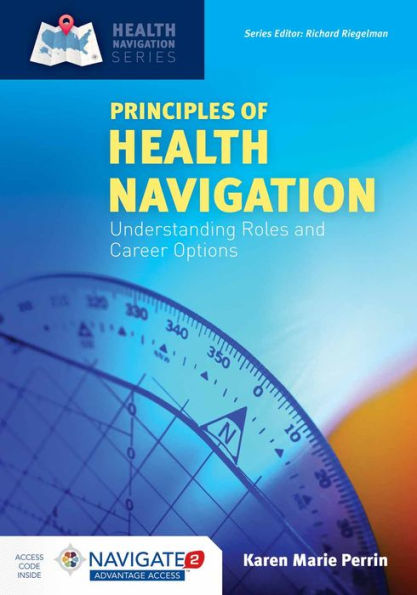Principles of Health Navigation: Understanding Roles and Career Options: Understanding Roles and Career Options available in Paperback

Principles of Health Navigation: Understanding Roles and Career Options: Understanding Roles and Career Options
- ISBN-10:
- 1284090760
- ISBN-13:
- 9781284090765
- Pub. Date:
- 09/21/2016
- Publisher:
- Jones & Bartlett Learning
- ISBN-10:
- 1284090760
- ISBN-13:
- 9781284090765
- Pub. Date:
- 09/21/2016
- Publisher:
- Jones & Bartlett Learning

Principles of Health Navigation: Understanding Roles and Career Options: Understanding Roles and Career Options
Paperback
Buy New
$78.51Buy Used
$47.97
-
SHIP THIS ITEM— Not Eligible for Free Shipping
-
SHIP THIS ITEM
Temporarily Out of Stock Online
Please check back later for updated availability.
-
Overview

Product Details
| ISBN-13: | 9781284090765 |
|---|---|
| Publisher: | Jones & Bartlett Learning |
| Publication date: | 09/21/2016 |
| Edition description: | New Edition |
| Pages: | 286 |
| Product dimensions: | 7.00(w) x 9.90(h) x 0.70(d) |
About the Author
Table of Contents
Chapter 1 Healthcare Personnel 1
Learning Objectives 1
Chapter Overview 1
Case Study: Part 1 1
Healthcare Personnel 3
Case Study: Part 2 6
Case Study: Part 3 8
Case Study: Part 4 10
Summary 15
Part 1 Prevention and Community Health 17
Chapter 2 Preventive Health Care through the Life Span 19
Learning Objectives 19
Chapter Overview 19
Health Navigation Professionals 19
Levels of Preventative Care 22
Secondary Prevention 26
Tertiary Prevention 26
Risks and Risk Assessment 28
Summary 35
Chapter 3 Role of Public Health Institutions in Healthcare Delivery 37
Learning Objectives 37
Chapter Overview 37
What Is Public Health? 37
U.S. Federal Structure and Agencies Related to Health 38
State, County, and Local Health Organizations 49
Scenario: Preparing for a Disaster 49
Summary 56
Part 2 Introduction to Health Care and Health Insurance 59
Chapter 4 Inpatient Healthcare Services 61
Learning Objectives 61
Chapter Overview 61
Hospitals 61
Residential Healthcare Facilities 65
Summary 68
Chapter 5 Outpatient Healthcare Facilities 71
Learning Objectives 71
Chapter Overview 71
Wellness and Preventative Facilities 71
Outpatient Medical Facilities 72
Private, Group, or Corporate Medical Offices 73
Types of Clinics 74
Pharmacy 76
Outpatient Ambulatory Surgical Centers (OASC) 77
Other Outpatient Services 77
Treatment Centers 81
Summary 82
Chapter 6 Health Insurance 85
Learning Objectives 85
Chapter Overview 85
History of Health Insurance in the United States 85
International Comparison with the U.S. Health System 89
Types of Health Insurance 93
Medicare and Medicaid 97
Health Insurance Terminology 99
Case Study One 100
Case Study Two 102
Summary 103
Chapter 7 Defining Quality in Health Care 105
Learning Objectives 105
Chapter Overview 105
Defining Quality 105
National Regulatory Agencies 107
The Joint Commission 109
National Committee of Quality Assurance (NCQA) 110
National and State Insurance Commissioner's Office 111
Healthcare Organization Committees Related to Quality 112
Institutional Review Board (IRB) Committee 112
Summary 114
Part 3 Care of the Individual 117
Chapter 8 Individual Assessment 119
Learning Objectives 119
Chapter Overview 119
Life Story 119
Health Outcomes Influenced by Social and Cultural Norms 120
Health Disparities 120
Electronic Medical Record (EMR) 128
Summary 131
Chapter 9 Infectious Disease 137
Learning Objectives 137
Chapter Overview 137
Prevention and Control of Infectious Disease 138
Infectious Diseases: Immunizations and Descriptions 142
Infectious Diseases: No or Limited Vaccines Available 144
Summary 149
Chapter 10 Noncommunicable Disease 153
Learning Objectives 153
Chapter Overview 153
Epidemiology 153
Types of Noncommunicable Diseases 155
Summary 170
Chapter 11 Health-Related Quality of Life (HRQOL) and End-of-Life Planning and Decisions 173
Learning Objectives 173
Chapter Overview 173
Quality of Life 173
Healthcare Decisions 184
End-of-Life Issues 187
Termination of Medical Treatment 192
End-of-Life Care: Options 195
Summary 197
Part 4 Accessing and Analyzing Health Information 201
Chapter 12 Health Literacy 203
Learning Objectives 203
Chapter Overview 203
Adult Literacy and Numeracy 204
Health Literacy 204
Developing Health Materials 208
Numbers 214
Visuals 215
Customer Service 217
Configuration of a Positive Environment 219
Patient Responsibilities 220
Healthcare Provider Responsibilities 221
Summary 224
Chapter 13 Accessing and Using Health Information Richard Riegelman 227
Learning Objectives 227
Chapter Overview 227
Accessing High-Quality Health Information on the Internet 228
Suggested Websites 230
Accessing and Using Public Health Information 230
Measures of Population Health 232
Displaying Health Information 233
Using Health Information to Establish Cause and Effect as well as Effectiveness and Safety 237
Criteria for Definitively Establishing Contributory Cause 238
Establishing Effectiveness and Safety of Treatments 240
Summary 241
Chapter 14 Analyzing Health Information for Clinical Practice Richard Riegelman 243
Learning Objectives 243
Chapter Overview 243
Using Health Information to Diagnose Health Problems 243
Using Information from Testing in Clinical Practice 246
Screening for Asymptomatic Disease 247
Other Uses of Testing 249
Using Health Information to Make Treatment Decisions 250
Health Information on Treatment with Prescription and Nonprescription Drugs 252
Evidence-Based Recommendations/Practice Guidelines 254
Grading of Evidence-Based Recommendations 255
Electronic Health Records (EHRs) 257
Summary 259
Glossary 263
Index 283
